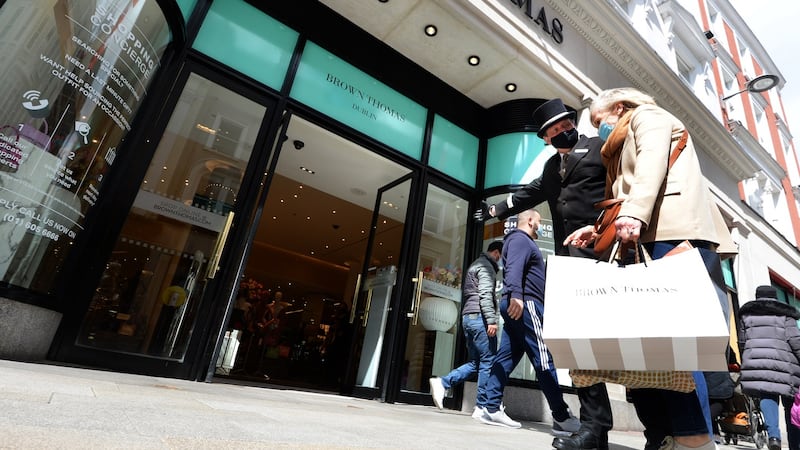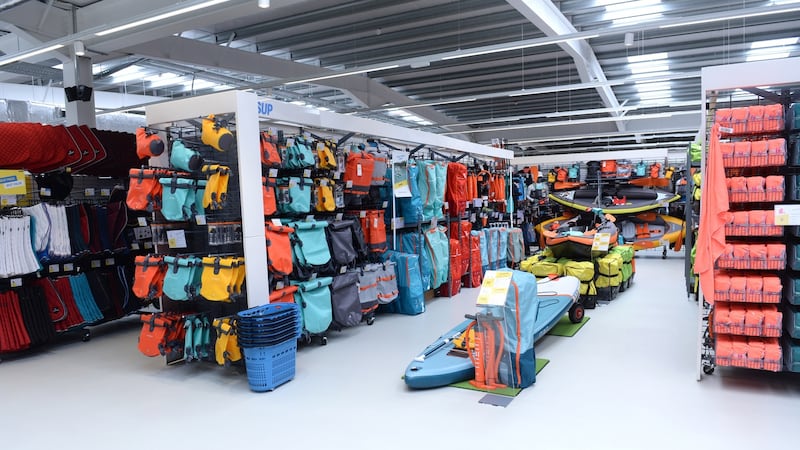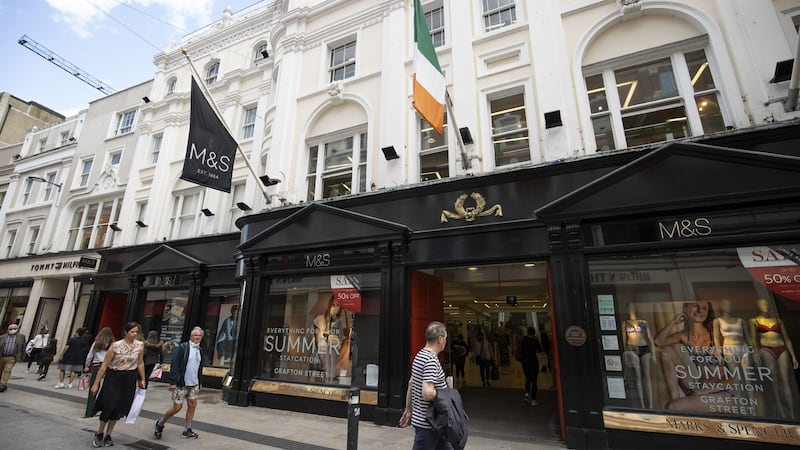Today is the day non-essential retail finally gets to reopen; but while many shop owners around the country will be gratefully pulling up the shutters and greeting customers once more, there will be many who won’t.
On Dublin’s Grafton Street, a host of shops, formerly occupied by the likes of Tommy Hilfiger, Fitzpatricks, Ecco, Urban Decay, Pamela Scott, Topman, Monsoon and Cath Kidston, will remain closed. In fact, almost one in five shops on the street won’t be reopening today.
And they may not be the only ones.
0 of 12
"I wouldn't be surprised if a couple of [other] shops don't reopen," says Eoin Feeney, deputy managing director and head of retail at BNP Paribas Real Estate Ireland.
After the longest lockdown in Europe, it’s no surprise that streets such as Grafton Street are suffering. The question, however, is whether or not the empty units that line the street are simply a Covid-19-induced temporary blip. Or are they, rather, signs of a deeper structural change which means that the heady days of key-money reviews on Ireland’s priciest shopping street are gone forever.
Bond Street of Dublin
The raft of recent closures is a far cry from 2008. Back then the street was heralded as the fifth most expensive in the world, behind the main shopping boulevards of New York, Hong Kong, Paris and Milan – and ahead of London’s Bond Street and Zurich’s Bahnhofstrasse. Landlords on the street charged €5,621 per square metre per annum, compared with €12,612 on New York’s Fifth Avenue.
But the stature of the street has been diminishing for some time. With shops left empty, it has been host to a number of pop-ups in recent years; in 2017 German discount grocer Lidl opened a pop-up shop at 32 Grafton Street to sell its Heidi Klum-branded clothing range, while the National Council for the Blind opened a temporary shop at the Trinity College end of the street before Christmas.

This lack of demand has had a knock-on effect on rents. Hugo Boss agreed a 24 per cent reduction on its rent when it agreed a new 10-year lease at 67/68 Grafton Street in January of this year, equating to €1,177 per square metre, while Tommy Hilfiger recently agreed to pay a year's rent just to exercise its 15-year break option early. If and when a replacement is found for the unit, it's unlikely to be at previous levels.
Last year Ecco said it would leave the street after a dispute over rents with landlord Irish Life; but the rent it was paying, of €210,000, was already less than half what the former tenant Korky's had paid for the unit.
Indeed, the street itself being devalued. The MSCI/Society of Chartered Surveyors Ireland (SCSI) index, which traces unlevered total returns of more than 490 commercial property investments, reported a decline of 23.3 per cent for Grafton Street, with Henry Street suffering an even bigger fall, of 27.2 per cent. As a comparison, valuations for retail parks fell by just 7 per cent.
Vacancy rates
Many of the issues on the street come down to problems in UK retailing, with the collapse of Philip Green’s Arcadia Group leading to the departure of a host of names such as Topshop, Topman and Monsoon from Dublin’s city centre.
Richard Guiney, chief executive of Dublin Town, an association established by Dublin businesses to promote the city centre, calculates the vacancy rate on the street as being 18 per cent; this means that almost one in five shops are now vacant.
“We wouldn’t have seen anything like that in the last recession,” he says, noting that the average in 2011 for the city as a whole was about 15 per cent. “For a prime street it’s a lot higher than we’d like to see.”
And with falling demand comes falling rents.
For Guiney, there is still interest in investing on Grafton Street, “but whether they are willing or able to pay the rents paid pre-pandemic is a different question”.
French sports retailer Decathlon is a case in point.
It opened its first Irish outlet in Ballymun mid-pandemic last year, and had been set to sign a lease for a click-and-collect type outlet on Grafton Street this January. However, the length of retail restrictions put paid to this.
As did rents.

Citing a significant decline in city-centre footfall, Bastien Grandgeorge, chief executive of Decathlon Ireland, says Dublin rents per square metre are still nonetheless among the most expensive in Europe.
“We still aim to have a presence in the city centre of Dublin one day, and we are open to discussion for a lease,” he said. “However, for the moment the reality of commercial rental market has not moved enough with this reality. Hopefully in 2022 if the rental market moves?”
Falling rents
And move it might.
Feeney says rents are now at about 60-65 per cent of 2006 levels, and will drop further.
“Rents dropped last year and will drop this year and will drop next year. There are more shops than occupiers,” he says.
But how much they fall may depend on the ownership of the street, which is concentrated among five property funds: Irish Life, Iput, Aviva, Davy and State Street Global Advisors.
Some landlords are focused on generating income and are said to be open to doing deals to achieve this. Others, however, may be looking at the long term.
Indeed, much like the institutional landlords who are keeping apartments vacant along the docks rather than drop rents to a new, lower benchmark, some fear that certain owners are waiting for the market to recover.
“When it comes to valuations given to property, there’s a certain incentive on a personal or corporate level to want to hold on. But my own view is you’ll be holding on for a long time,” says Guiney.
And in the meantime, so many high-profile empty units can exert a further downward pressure on rents. As Feeney notes, a high vacancy rate is “like cancer – it spreads”.
Going forward, he predicts a two- or three-tier market, with higher rents paid by retailers who want to be in a certain position on the street, such as close to Brown Thomas, with lower rents elsewhere.
Planning restrictions
A further complication in delivering retail – of whatever type – is the special planning rules that govern Grafton Street. At the top of the street, bordering St Stephen’s Green, is the empty Topshop unit. The original tenant of the building was Robert Smyth & Sons, an upmarket grocer to genteel society.
However, if a new tenant wanted to bring the unit back to its original purpose, it would have to take on the risk of securing change-of-use planning.
Indeed, when cosmetics group Rituals wanted to set up a store in the old H Samuel unit, it had to submit a change-of-use planning to the council.
“We need to relax that,” says Feeney.

A further issue that a lot of the stores currently on the market are smaller, and not always suitable for a major retailer that is not already in the Irish market, such as Uniqlo.
New uses
There is already a sense then that the traditional retail element of Grafton Street may have to be set aside in favour of other pursuits.
“Even before the pandemic we knew we’d see less retail, we don’t think there will be a queue of entrants to occupy the space Arcadia had,” says Guiney.
This structural change has been exacerbated not just by the move online but also by the move to working from home. If people are in their office only two or three days a week post-pandemic, then they’re going to be shopping on Grafton Street proportionally less.
“We’re going to have to look at new uses for the street,” says Guiney.
Already, this shift has started. At 85-86 Grafton Street, a building occupied at ground level by Clarks, and previously by Pamela Scott, the owner Irish Life has just submitted a change-of-use request to the council. It is looking to convert the first floor, which had been used by Pamela Scott as a retail space, to office use. A decision has not yet been made.
It doesn’t mean that retail on the street is finished.
Both Guiney and Feeney agree that the outlook for Grafton Street is only likely to improve.
“This is the worst,” says Feeney.
Indeed last November, British shoe retailer Clarks identified a number of stores it deemed “financially unviable”, including 10 across Ireland. However, while Henry Street was one such store earmarked for closure, the retailer deemed its outlet on Grafton Street, as well as its one in Dundrum Town Centre, as being “profitable”.
Decathlon’s chief Grandgeorge is “ready and willing to invest”, while a number of retailers are understood to be looking at the street.
But it may well have a slightly different flavour going forward.
And who knows, maybe it could target a new audience à la Brown Thomas owner Selfridges. The London department store has just been granted a licence to host weddings; for couples who used to meet outside Clery’s clock, it could bring the romance full circle by saying “I do” amid the handbags and bed linen.
























